Sporting CP ended a 19-year Primeira Liga drought last season and finished second in 2021/22.
At the heart of their improvement was João Palhinha, the physically imposing holding midfielder. A former academy product, Palhinha’s return from a two-year loan at Braga secured the Sporting midfield, giving them one of the top defensive sides in Portugal.
The past two seasons have also led to Palhinha’s inclusion in the Portuguese national team. Time at Braga played a massive role in his development, but it was with Sporting Portugal that saw him leap in status.
After two excellent seasons, it’s natural to find him among the transfer rumours. With compatriot Rúben Neves linked to Man United, Arsenal and Barcelona, Wolves need a new pivot and Palhinha is the long-desired target. There’s talk of an “imminent deal” between the West Midlands club and Sporting.
This transfer, as well as the fate of Neves and Mattheus Nunes, signals a time of transition for each clubs’ midfield.
With the Portuguese presence on their roster, Wolverhampton fans will likely have an idea of the player. For those who aren’t familiar with Pahlinha or wish to improve their understanding of his qualities, this scout report profiles his talents and explores his top traits through tactical analysis.
Profiling João Palhinha
Let’s start the analysis with a look at Palhinha’s data profile. Rather than creating a comparison relative to Portuguese Primeira Liga defensive midfielders, the profile below shows his percentile rank among pivots and central midfielders in midfield fours across UEFA’s top six leagues.
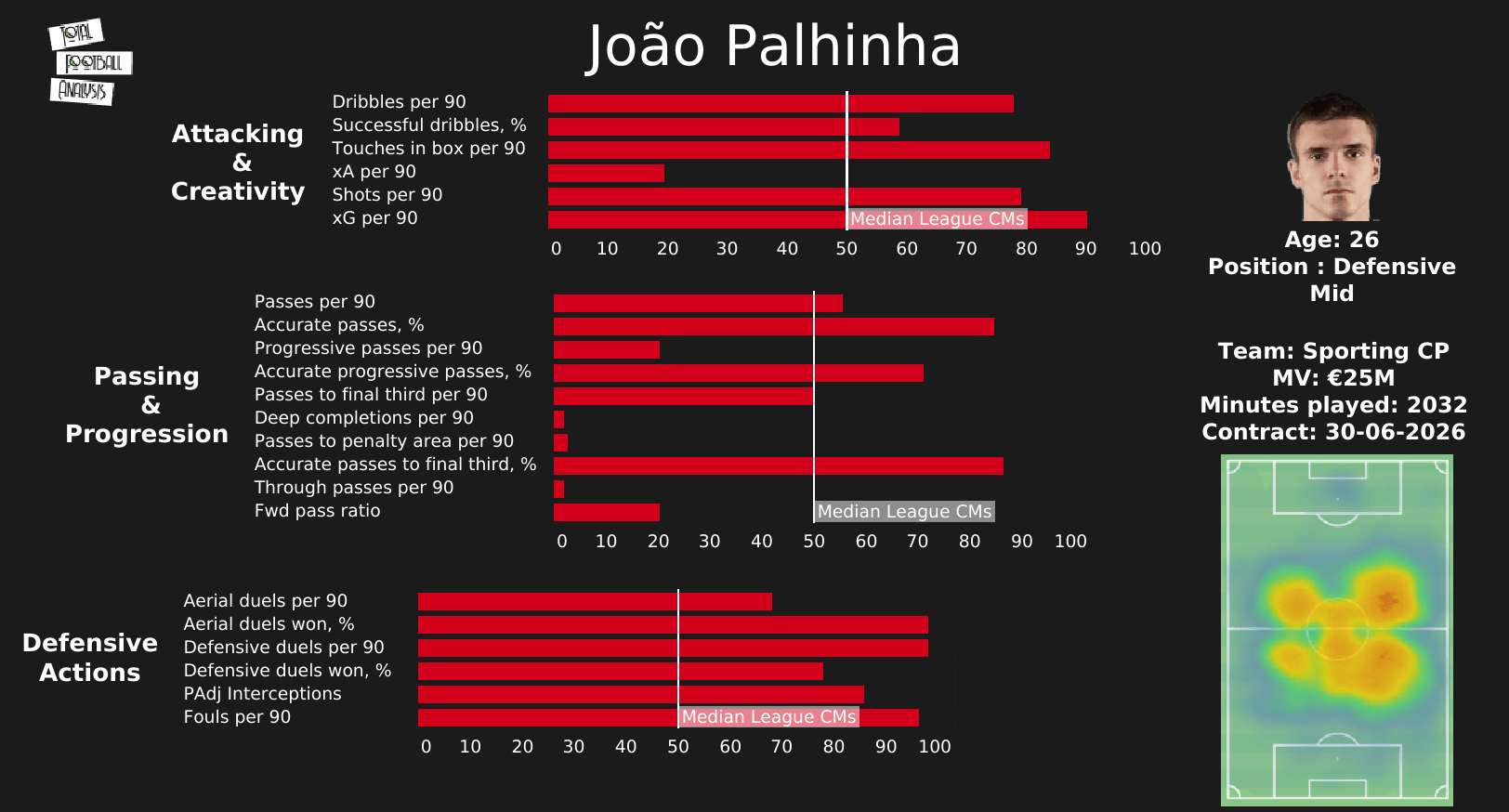
From an attacking standpoint, he uses the dribble very well, frequently attacking space and winning his duels. He stands at 190cm and is a physically strong player, able to hold off opposing defenders. Although he’s not the fastest or quickest, his strength allows him to hold off opponents on the dribble. When he does venture forward, Palhinha has a penchant for continuing his runs into the box. Whether from set-pieces or open play, his box presence is a real weapon that Sporting has utilised.
In terms of passing and progression, his passes p90 and passing accuracy ratings are very good, but he does rate at the lower end of the scale in terms of his forward pass ratio and final third contributions. Generally speaking, you’ll find Palhinha in a deeper position protecting his backline. The freedom he affords Sporting allows his central midfield partner, often Nunes, to play more of a box-to-box role while Palhinha protects the team from opposition counterattacks.
He does have the ability to pick out intermediate and long-range targets, but Rúben Amorim’s tactics typically require Palhinha to play more safely and use his press resistance as a central bounce player. That, in turn, allows the centrebacks to more easily play into their wing targets.
Finally, we have the section on defensive actions. Here, we have Palhinha’s greatest strength and contribution to the squad. He dominates aerial duels, is one of the most involved tacklers in the game and still ranks in the 85th percentile in possession-adjusted interceptions. When opponents do manage to beat him, Palhinha has a “ball or man” mentality. Even if the ball gets by him, odds are the man won’t, as he’ll bring them down with a foul, protecting his backline from difficult interventions.
As mentioned, Palhinha’s not the quickest or fastest player. For a midfielder, he’s quite average in both categories. However, his read of the game keeps him a step or two ahead of opponents. His positioning is fantastic and his pitch awareness keeps him well-positioned for action. He’s best when he keeps space tight with the opposition. That allows him to use his reach and strength to overpower opponents and claim victories in duels.
In terms of a positional profile, he is a traditional defensive midfielder in Sporting’s 3-4-3 tactics. As mentioned in a previous analysis, Sporting uses Palhinha at the top of a diamond with his centre-backs. That allows the other central midfielder, typically Nunes, to operate in more of a box-to-box role, offering support to the three forwards and wingers, as well as positioning himself to make late runs from deep. The #8 typically leaves Palhinha as the lone defensive presence in midfield. It’s a complicated task with massive implications, but Palhinha’s pitch awareness and intelligence have seen him thrive in this role.
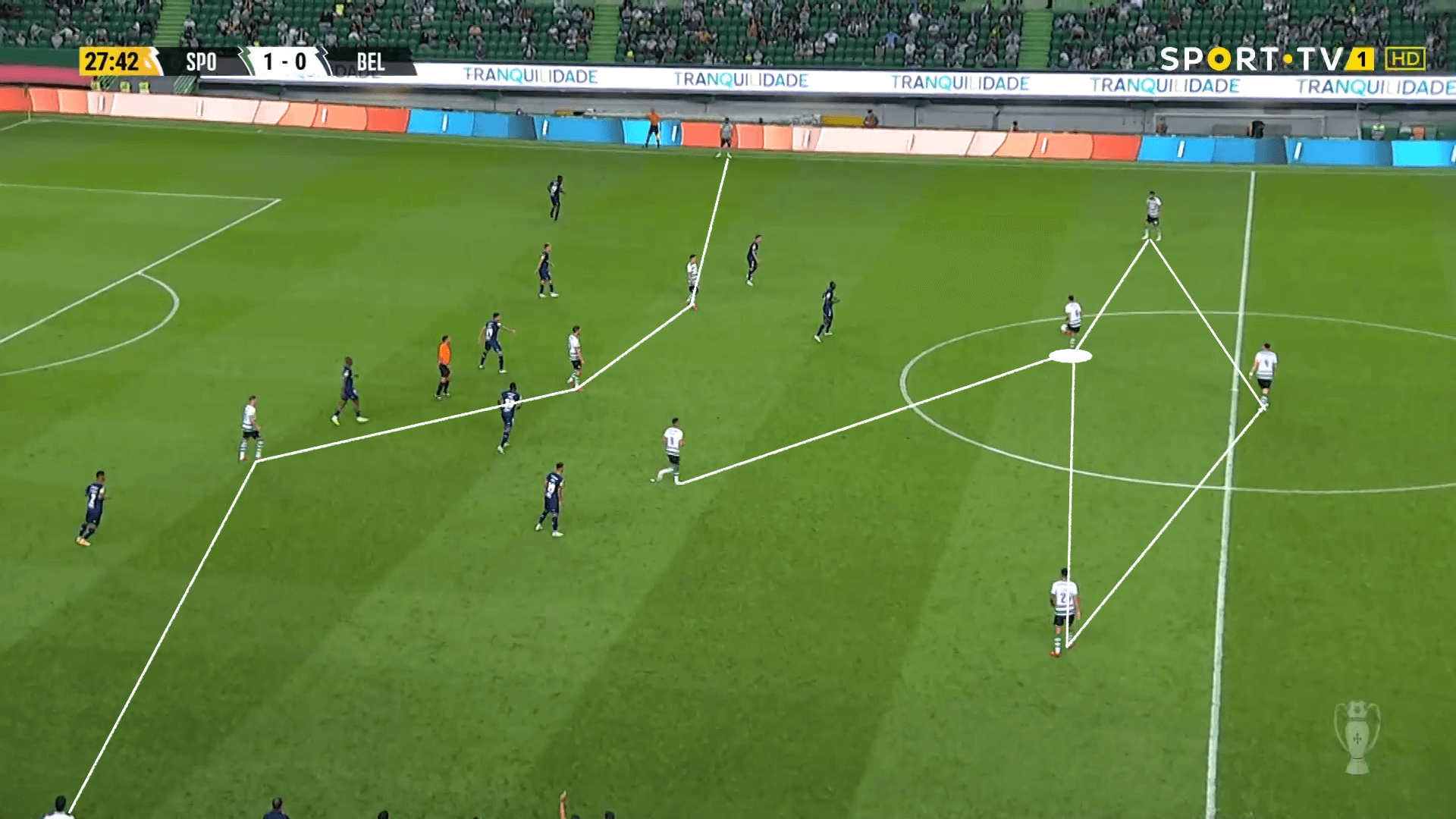
In open play, Palhinha will oscillate between positions outside of the press and between the lines. When positioned outside of the opposition’s press, he plays the role of a field general, directing teammates with his voice and hand gestures. Vocal leadership is one of his strengths, which again is based on his football IQ and competitiveness.
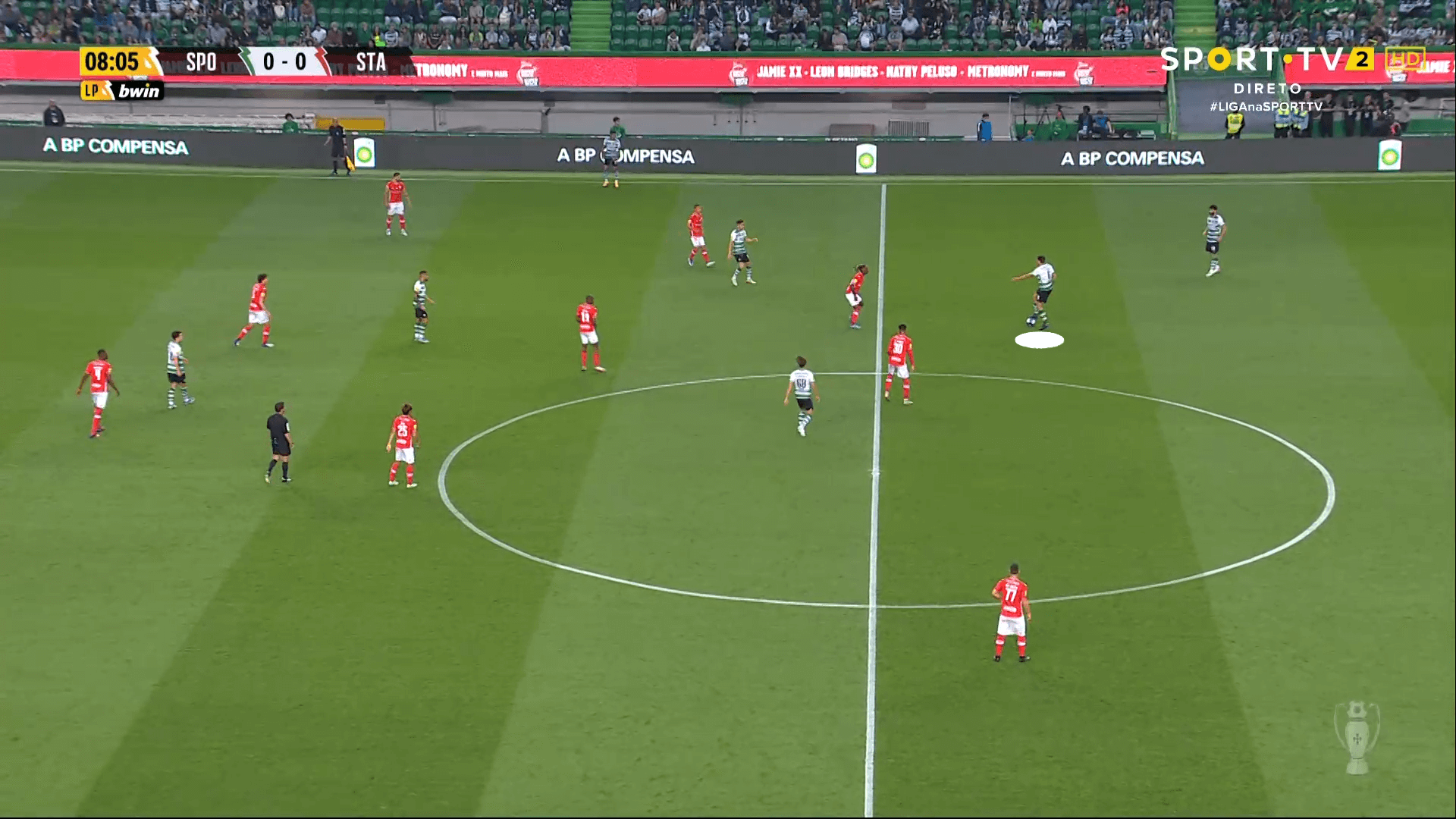
When positioned outside of the press, he uses short passes to unbalance the opposition and create space between the lines. Palhinha is an excellent scanner and constructs the attack with purpose. Leading with very calm, composed play, he skillfully moves the opposition to create the space he wants to attack from. Whereas the previous image shows him directing teammates and patiently circulating the ball, the image below shows both his arrival between the lines and his search for visual cues higher up the pitch.
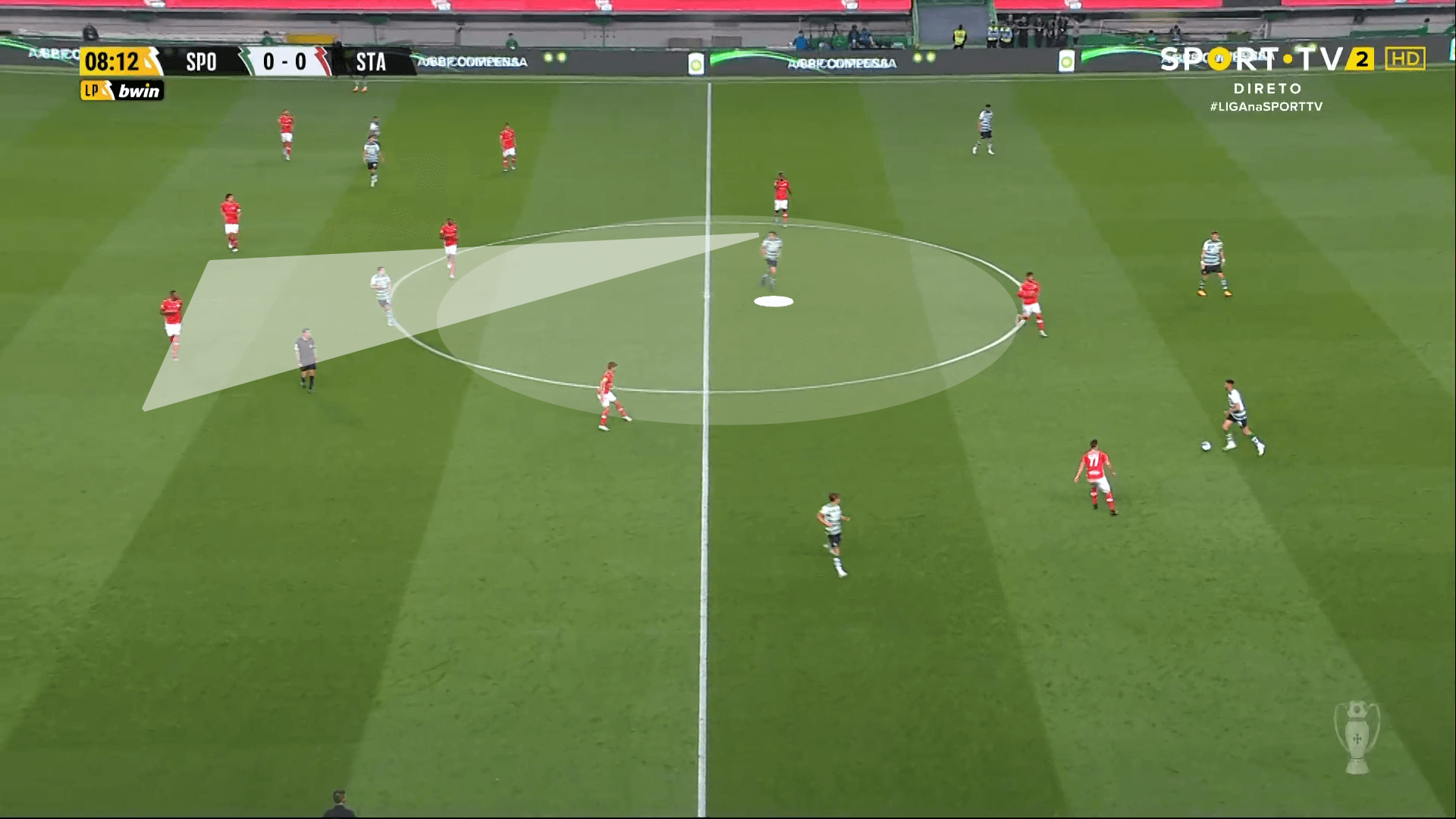
Palhinha is highly experienced in a central midfield two and has the defensive talent to remain in this role, especially within Bruno Lage’s system at Wolves. His key strength is the way he contributes defensively, but his positional orientation in possession also gives his central midfield partner freedom to venture higher up the pitch to influence the game. Palhinha’s midfield presence will be felt at the Molineux.
Defensive Presence
Let’s move the scout report into a deeper analysis of Palhinha’s defensive and attacking qualities. Since he has made a name for himself primarily through his defensive talent, that’s where we’ll start.
Perhaps his greatest defensive strength is down to his tactical awareness. He’s rarely out of position and has a knack for filling the right spaces. He balances his reference points well, taking away one threat while positioning himself to move on a second or third.
Take the example below. Sporting is at a numeric disadvantage centrally with Palhinha and Nunes defending 2v3 against the Belenenses midfield. Initially, Palhinha starts more centrally to keep them from progressing through the central channel. But look at his positioning and body orientation. Even though he has taken away the central threat, he knows the opponent in the half-space is likely to receive the next pass. The moment the first attacker sets his hips and feet, preparing to pass, Palhinha makes his move and intercepts the pass for an attacking half recovery.
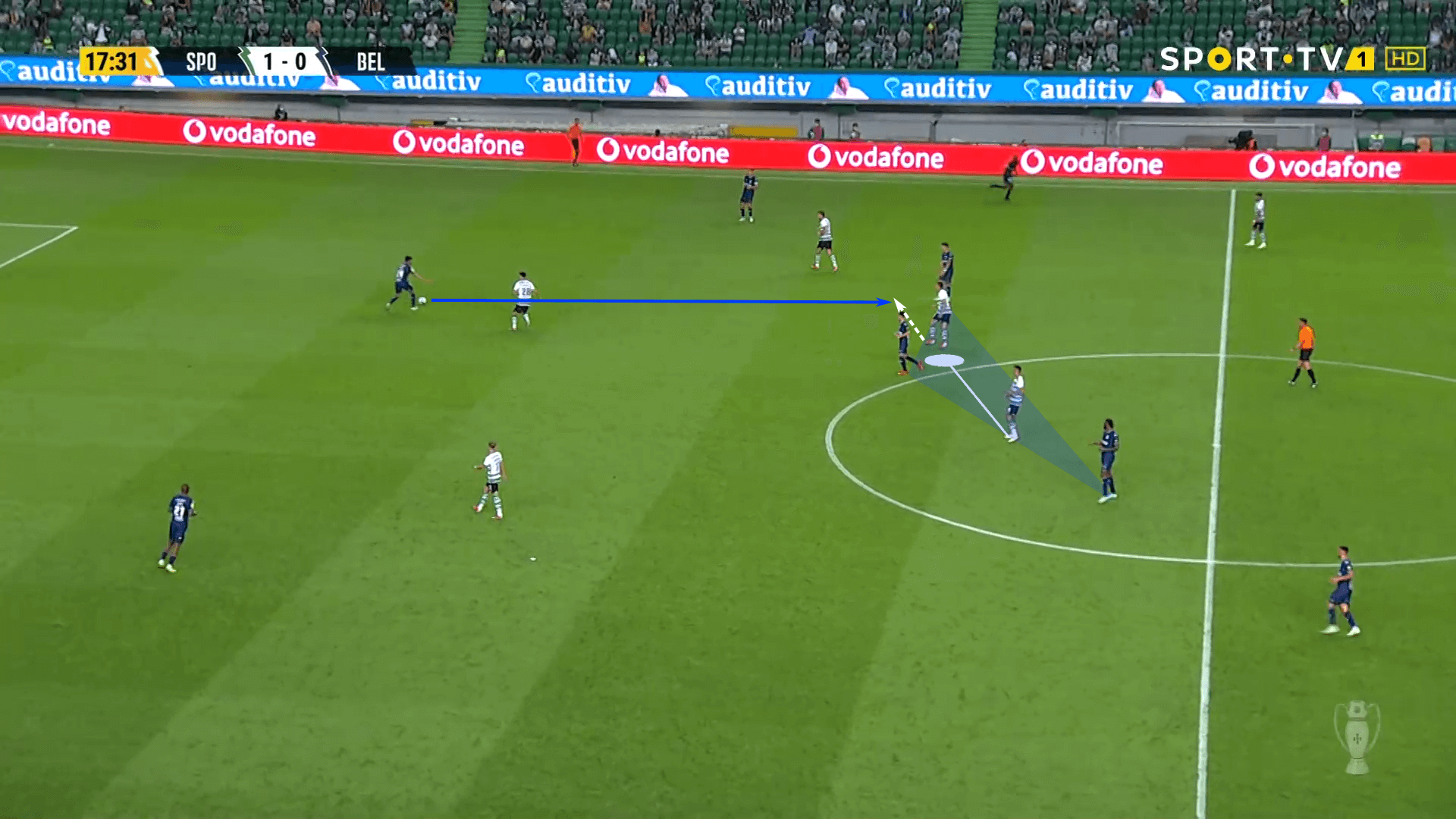
Positioning is one of his top strengths. Palhinha reads angles extremely well and can quickly identify the opponent’s top attacking options, then nullify those threats before they make an impact.
This is evident in his approach to tackling as well. Against Porto, the Dragões held a 4v3 advantage in the wing and had another option centrally. Despite the number of options available to the first attacker, Palhinha skillfully took away the top two threats with his approach, then poked the ball away for a 1v1 duel win. Sporting cleared the danger thanks to his understanding of the Porto players’ positioning relative to the ball.
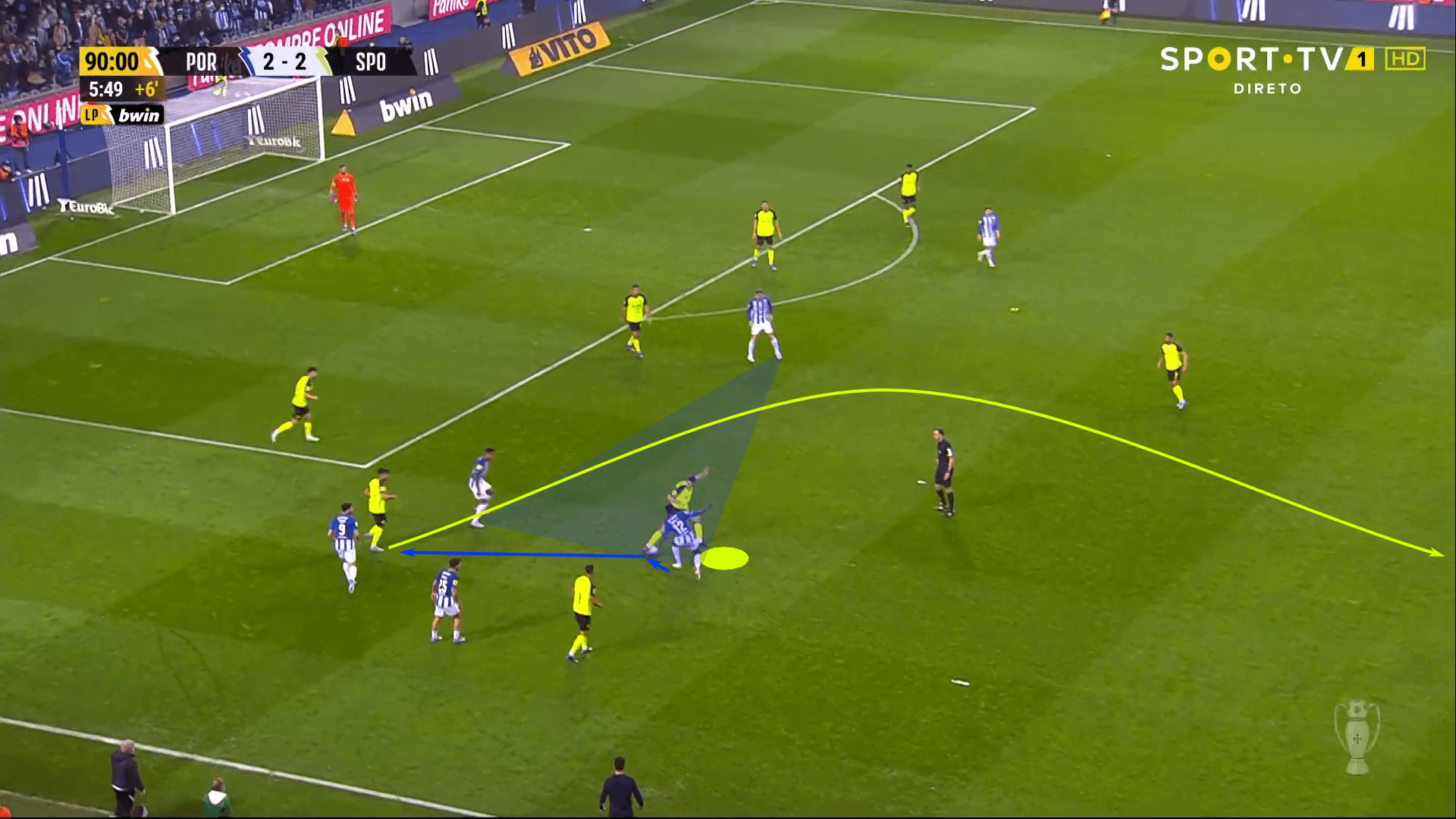
Palhinha’s use of length is on display in that example as well. He uses all of his 190 cm frame when defending, making the path around him more difficult. A very tough player, Palhinha defends with the physicality and aggression of generations past. His timing in the tackle is excellent and he shows a very good understanding of body mechanics. He reads the earliest physical cues of action and engages quicker than your average midfielder.
Much like previous generations, he does go to ground fairly often. This is one of the areas where we can see the quality of his defensive technique and timing. Even in a situation like the one below against Boavista, he’s just behind the attacker but makes an excellent slide around him to poke the ball free to a teammate. The sequence ended a counterattack for the home side and relaunched the Sporting attack.
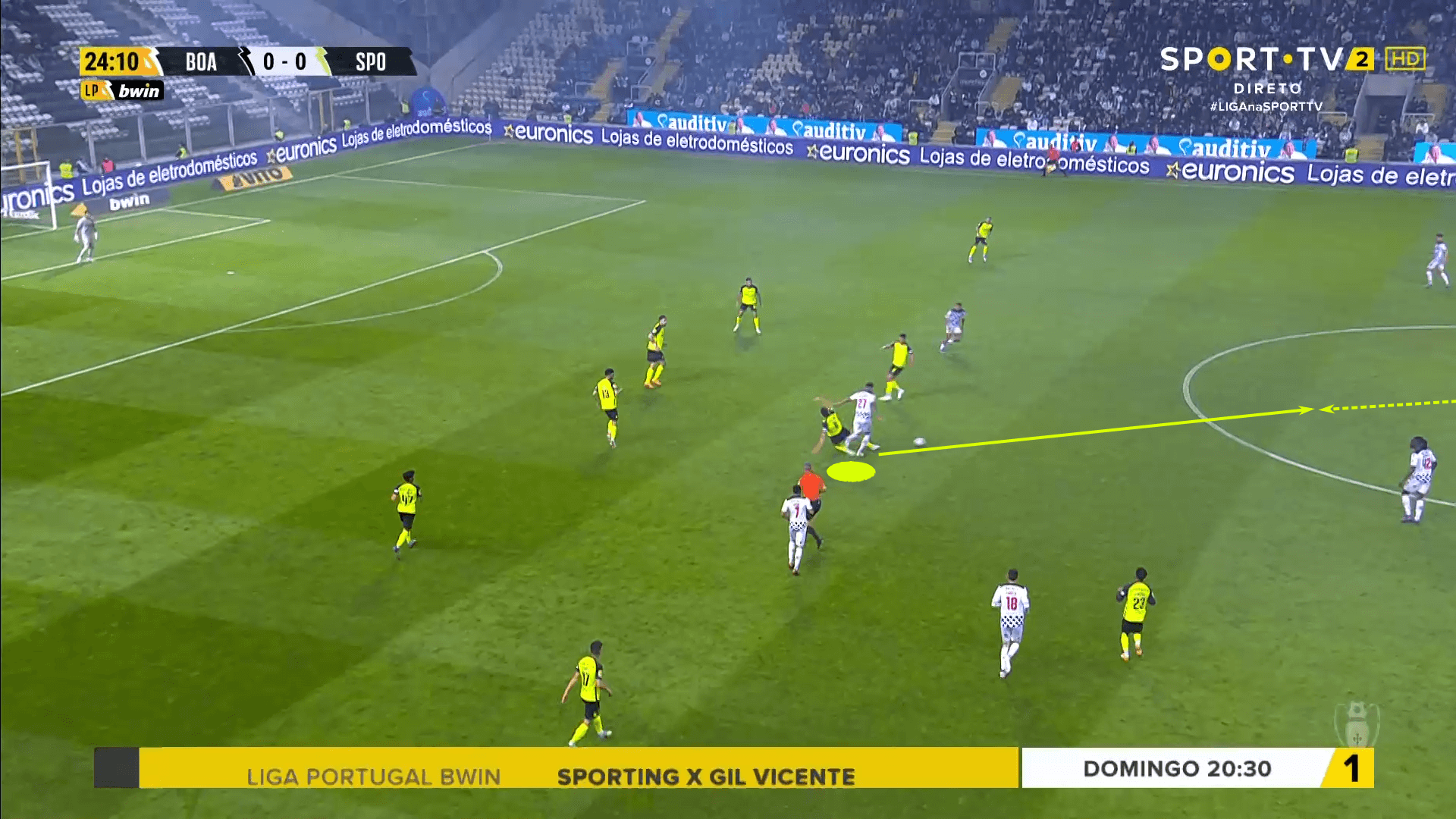
Speaking of counterattacks, Palhinha’s presence at the base of the midfield puts his defensive instincts on display. Sporting, as one of Portugal’s possession dominant clubs, relied on Palhinha to end the opposition’s counterattacking opportunities. Should they play into the high target, it was typically the 26-year-old Portuguese international who was called to intercept, tackle or foul.
In the counterpressing situation below, Palhinha initially held a deeper position in space to offer an outlet for his teammates. However, as the ball was lost, he quickly moved forward to condense space and help with the counterpress knowing that his centre-backs could handle Boavista’s numbers up top.
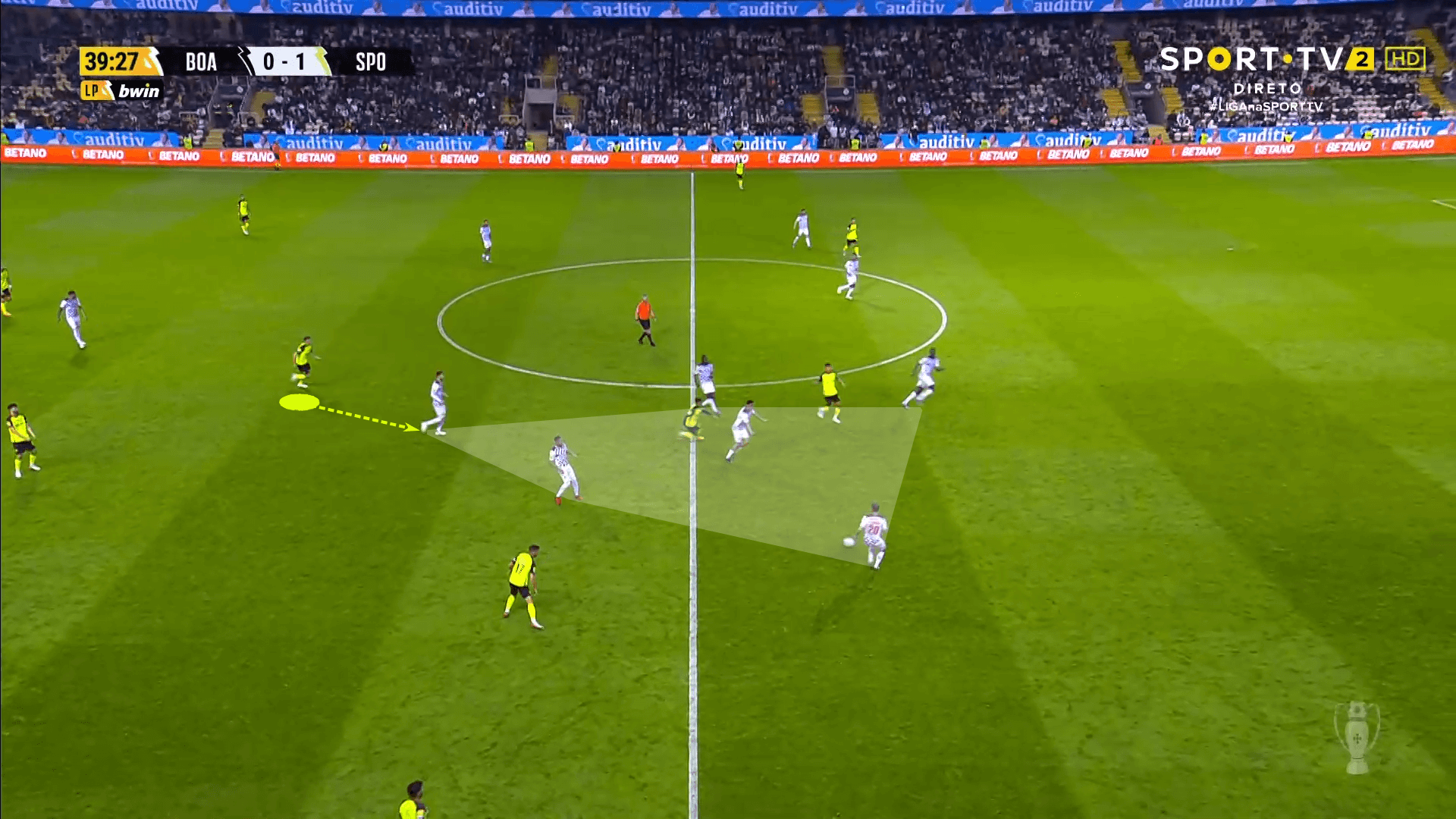
Finally, one thing Premier League fans will enjoy watching is Palhinha’s tackling technique. The final image from this section shows him winning a challenge, again ending a counterattack through his aggressive counterpressing.
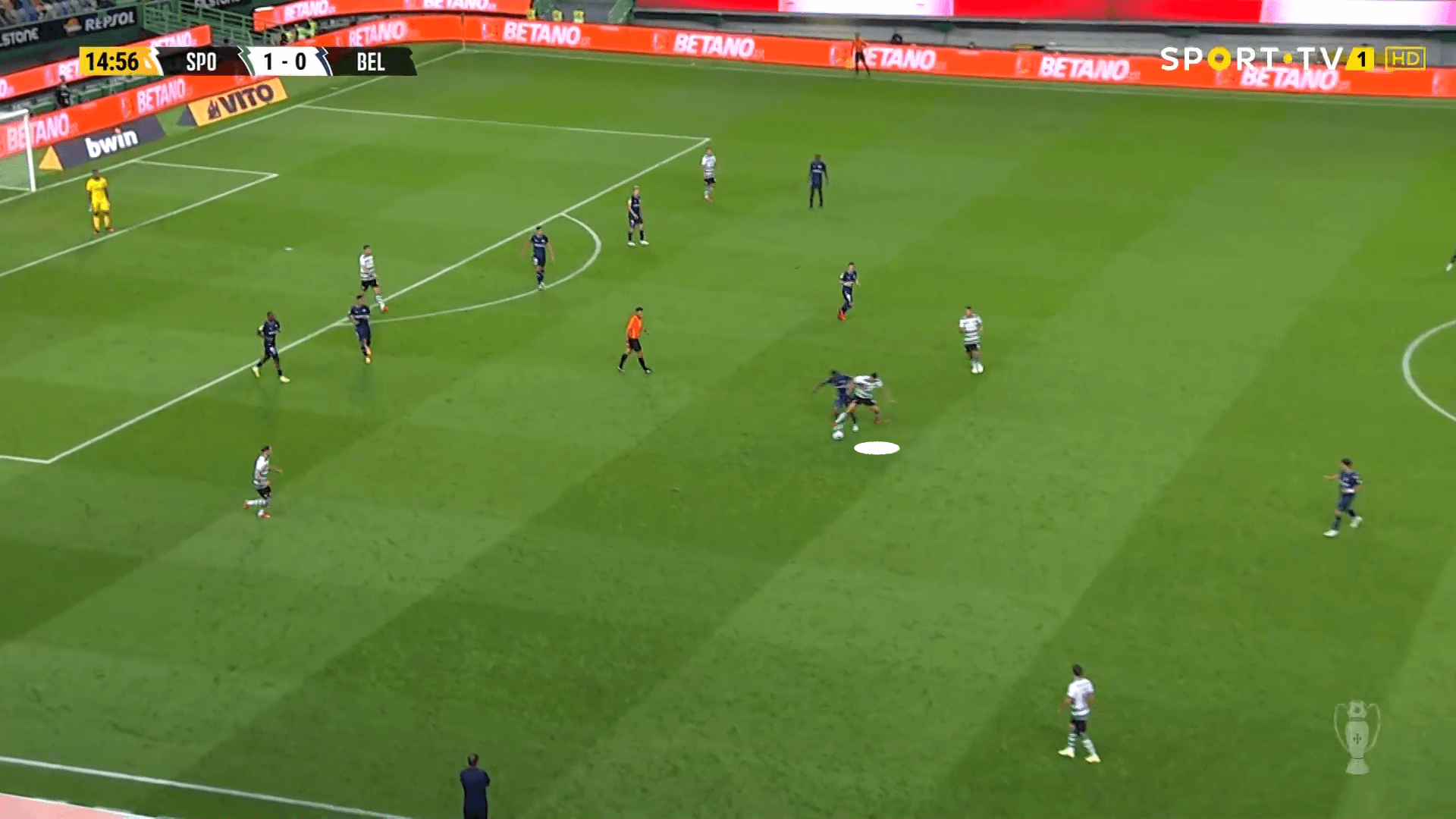
Going into the side block tackle, Palhinha makes very good use of his opponent-near hand and arm. Initially, he uses his hand and arm to knock his opponent off balance, then overpowered him to establish a dominant posture, separating the opponent from the ball with his hips and shoulders. His right foot possesses the ball while the rest of his right side seals the opponent from it, creating distance to secure possession.
Palhinha is a physical presence with an exceptional understanding of the game and defensive technique. He played a major role in Sporting’s first league title in 19 years and has become a regular for the Portuguese national team because of his midfield presence. He’s a physically dominant player and he’s eager to overpower opponents. He’s the kind of player midfield enforcers from previous generations will enjoy watching.
Attacking Contributions
Defence may be his top area of influence, but Palhinha is no slouch in possession either. His data profile might lead one to believe there are gaps in his game. After all, he reads very poorly in many key passing metrics.
Watching Sporting play, it’s less the case that he was incapable of playing passes into the final third and box than Palhinha understanding his role and showing tactical discipline. When he was asked to carry more of an attacking burden, Palhinha has shown the quality to match his ball striking to the technical demands presented to him. He can hit the long diagonal, send a decent ball over the top, or break a line with a 25-meter ground pass.
Pass maps from his top attacking performances show a player who is very capable of retaining possession and breaking the opposition’s press. Even with the number of long diagonal balls on the maps, his passing accuracy was excellent.
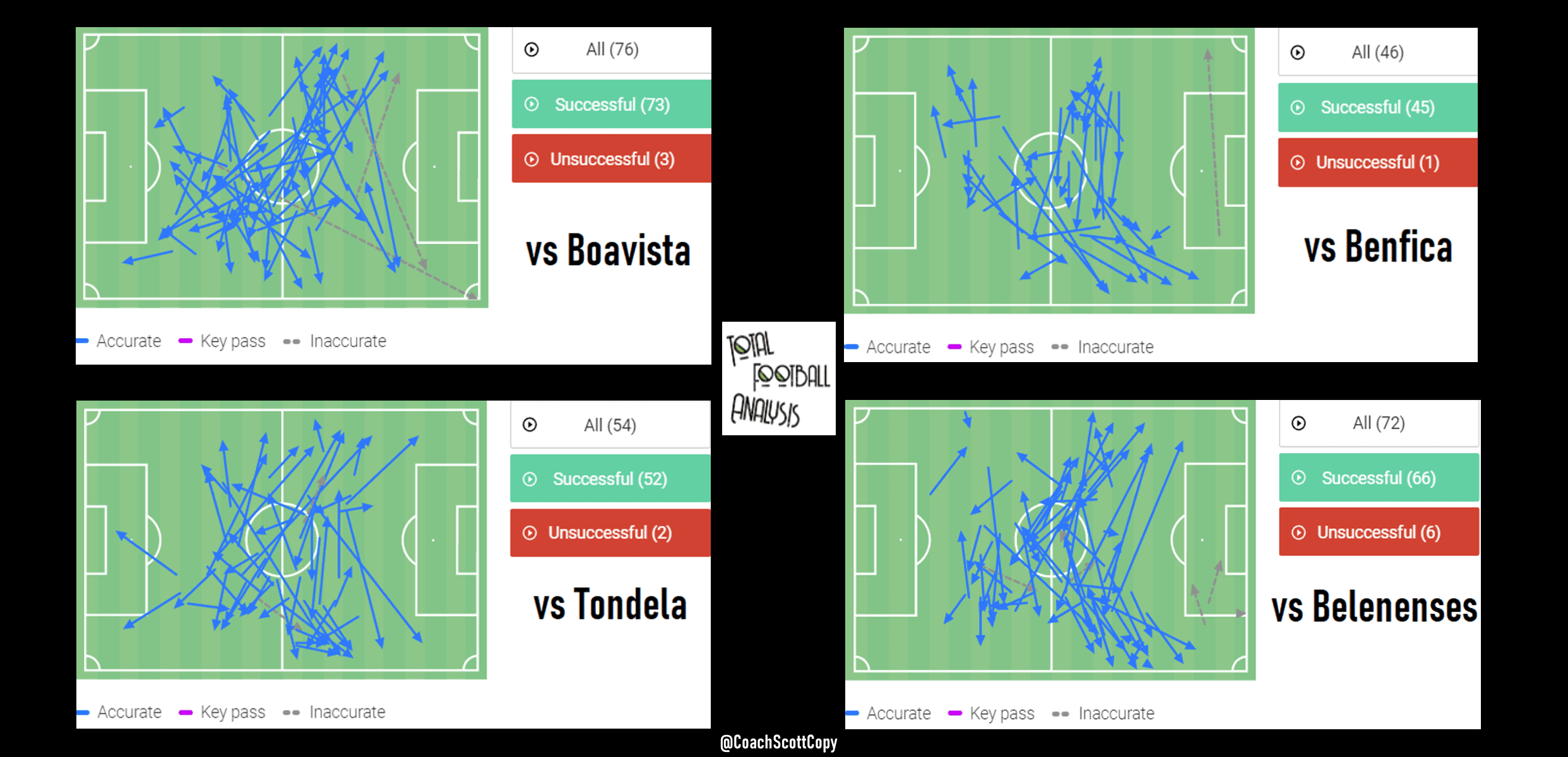
More often than not, that simply wasn’t what Amorim’s tactics asked of him. Instead, his job was to retain possession, bait the opposition into becoming more narrow and facilitate attacking conditions that allowed his centrebacks to play into key targets high up the pitch.
Palhinha also uses bounce passes effectively to get between the opposition’s lines. As he sets the ball back, you’ll find him drifting higher up the pitch as his mark moves the other direction towards the ball, just as we saw in the first section of this analysis. Keeping the ball on the ground and quickly circulating it is his preference, which is very consistent with Amorim’s tactics and the Portuguese footballing philosophy.
When asked to hit more challenging passes, the holding midfielder has shown good range and accuracy. In the final game of the season against Santa Clara, he opened the game with an exquisite pass through the Azoreans’ midfield. His pass found the feet of Pedro Porro, leading the Spaniard and allowing him to attack the box.
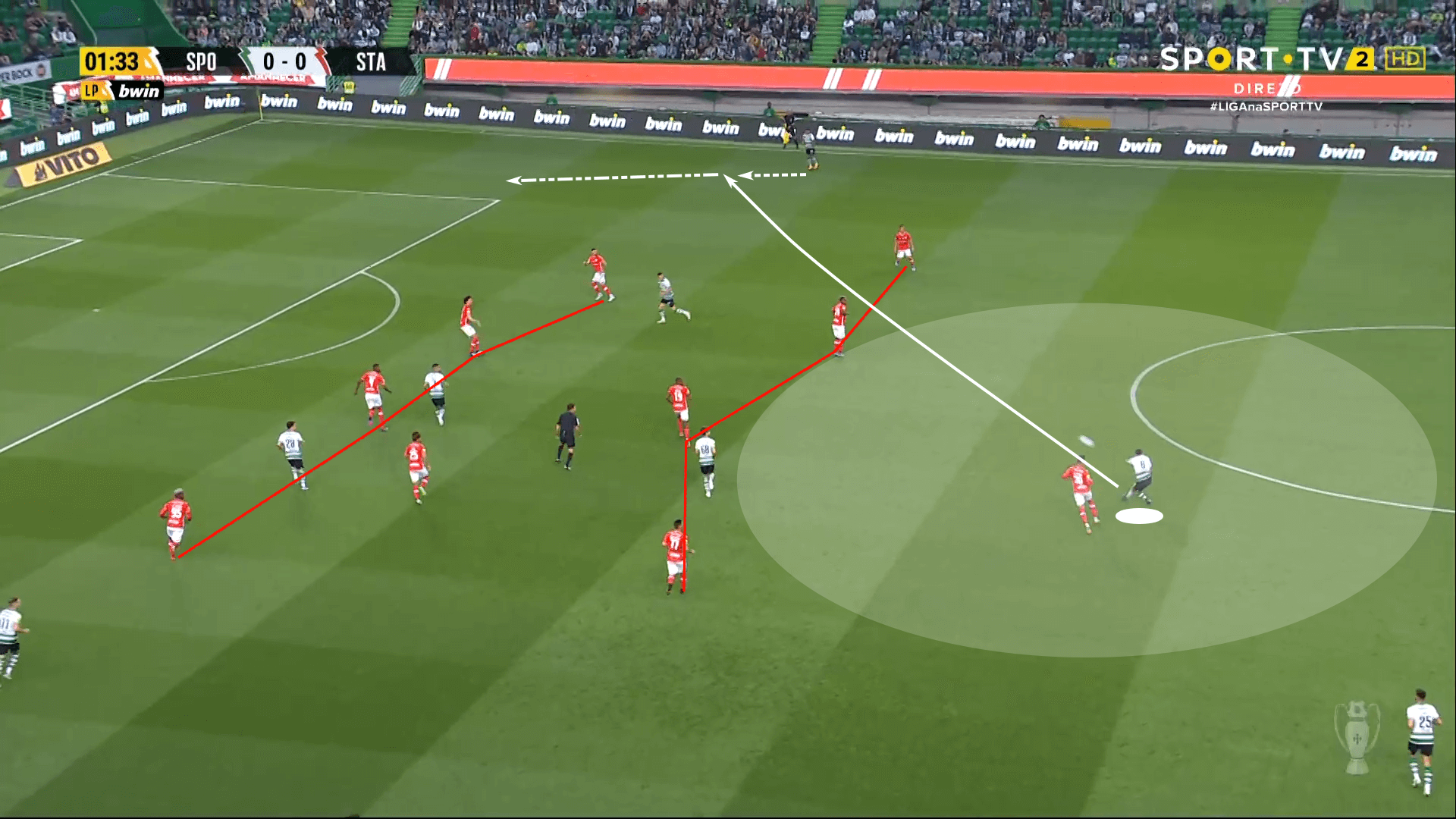
Notice the pocket of space he occupied leading to the pass. Two things to note are that by pulling himself outside of the opposition’s press, he increased his field vision, leading him to find Porro and play into him. Secondly, his positioning and Sporting’s rest defence has him perfectly situated to contest any outlet played into the lone Santa Clara striker. Through his positioning, he’s prepared to play the pass that beats the press or quickly transitions to defence if Sporting loses the ball.
Should the transfer to Wolves go through, Palhinha we’ll have more opportunities to display his passing range. Facing fewer low blocks, he will find more space to play over the opposition’s press, behind the back line or into the wings. Though he’s no Neves, Palhinha does show nice touch on longer-range passes.
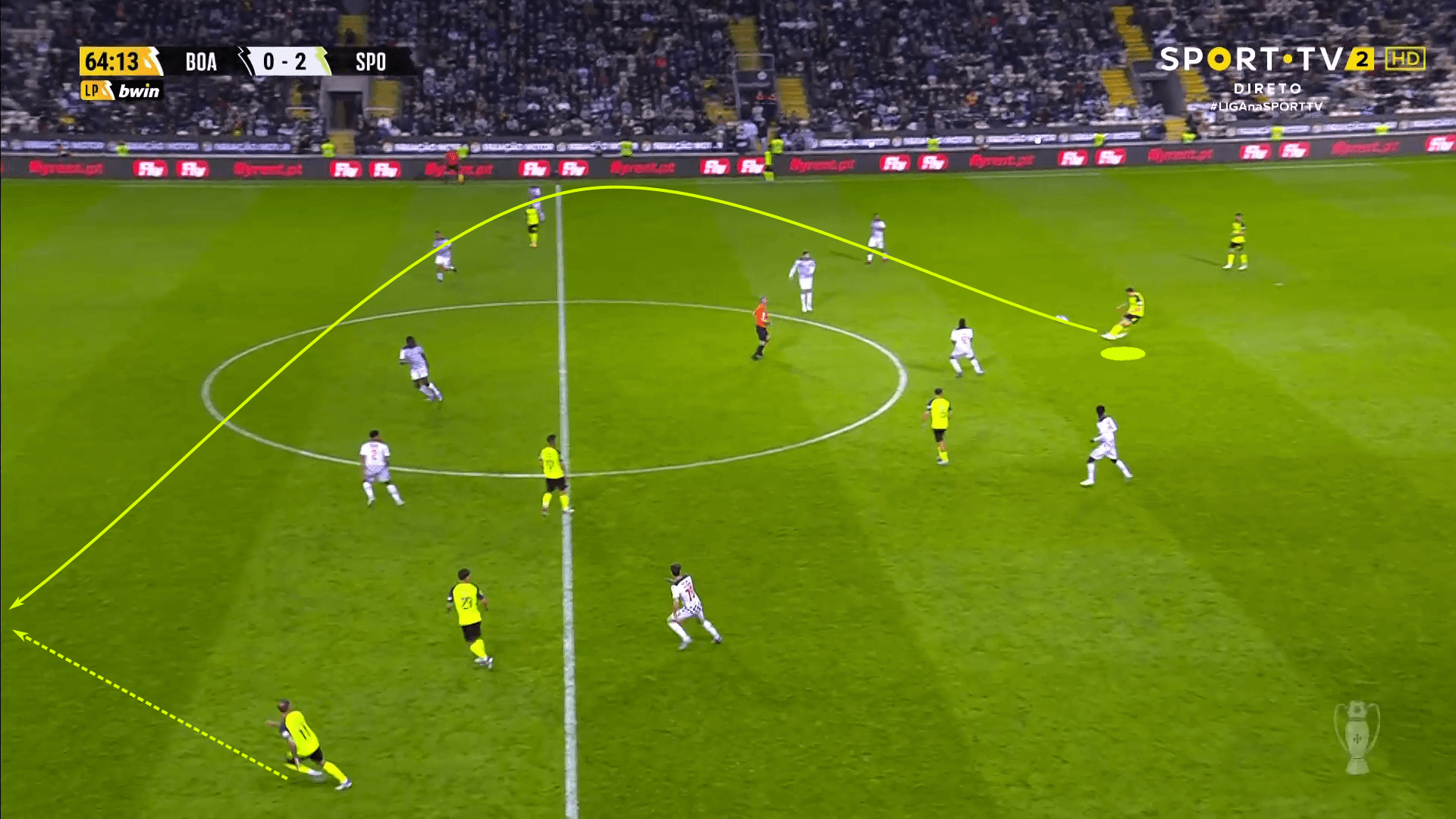
More impressive than his passing range is certainly his vision. Again, he won’t have the passing accuracy or range of a Neves, but he does show exceptional understanding of where his teammates are and how to approach the opposition’s press. He’s a very intelligent player on both sides of the ball and someone Wolves can trust to hit the high and wide targets.
Conclusion
If Palhinha has in fact played his last match for Sporting CP, there’s a 190cm void to fill in their midfield. Comparably sized Al-Musrati of Braga, Amorim’s former club, is linked to Sporting as a like-for-like replacement.
For Wolves, this is a signing that would reconfigure their midfield. With Neves out of the equation, Leander Dendoncker inching towards an exit and João Moutinho’s future in question, Palhinha gives them a physical central presence to build around. While he doesn’t have the passing range of Neves, his defensive qualities give Wolves some freedom when handpicking his partner. Nunes could join Palhinha on the journey from Lisbon to Wolverhampton, which makes an ideal central pairing for Lage.
Fulham is also interested in the Portuguese international as former Sporting coach Marco Silva prepares his roster for a Premier League return. Wolves are surely the favourites at the moment, but they’ll have to act quickly to wrap up the deal to fend off Fulham’s late advances.
Should the transfer push through in the coming days, Wolves have a great start to their midfield rebuild. The follow-up questions for the two clubs are 1) who replaces Palhinha at Sporting and 2) who’s the second midfield target for Wolves? Fans will wait impatiently as the two clubs navigate a time of transition.





Comments